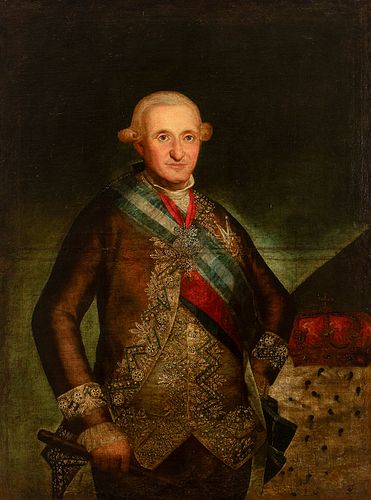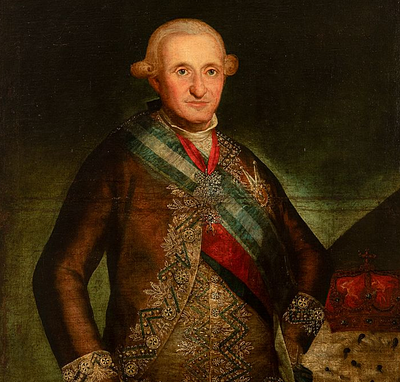Circle of FRANCISCO DE GOYA Y LUCIENTES (Fuendetodos, Zaragoza, 1746 - Bordeaux, France, 1828). "Portrait of Charles IV." Oil on canvas. Relined
Lot 35
About Seller
Setdart Auction House
Carrer Aragó 346
Barcelona
Spain
Setdart Subastas was born in 2004 and is currently the first online art auction in Spain with solidity, prestige and reliability guaranteed by our more than 60,000 users. Setdart has a young, dynamic and enterprising team ready to successfully manage the purchase and sale of art works through custom...Read more
Estimate:
EUR€16,000 - EUR€18,000
$16,494.85 - $18,556.70
Absentee vs Live bid
Two ways to bid:
- Leave a max absentee bid and the platform will bid on your behalf up to your maximum bid during the live auction.
- Bid live during the auction and your bids will be submitted real-time to the auctioneer.
Bid Increments
| Price | Bid Increment |
|---|---|
| EUR€0 | EUR€10 |
| EUR€200 | EUR€25 |
| EUR€500 | EUR€50 |
| EUR€1,000 | EUR€100 |
| EUR€3,000 | EUR€200 |
| EUR€5,000 | EUR€500 |
| EUR€10,000 | EUR€1,000 |
| EUR€20,000 | EUR€2,000 |
| EUR€50,000 | EUR€5,000 |
About Auction
By Setdart Auction House
Sep 22, 2021
Set Reminder
2021-09-22 09:30:00
2021-09-22 09:30:00
America/New_York
Bidsquare
Bidsquare : 22nd September - ARAS JÁUREGUI Private Collection - Old Masters, 19th & 20th Century
https://www.bidsquare.com/auctions/setdart-auction-house/22nd-september---aras-j-uregui-private-collection---old-masters-19th-20th-century-7427
ARAS JÁUREGUI Private Collection - Old Masters, 19th & 20th Century Setdart Auction House sofia@setdart.com
ARAS JÁUREGUI Private Collection - Old Masters, 19th & 20th Century Setdart Auction House sofia@setdart.com
- Lot Description
Circle of FRANCISCO DE GOYA Y LUCIENTES (Fuendetodos, Zaragoza, 1746 - Bordeaux, France, 1828). "Portrait of Charles IV." Oil on canvas. Relined It presents repainting, old restorations and a Carlos IV style frame from the end of the 19th century with damages. Measurements: 126 x 94 cm; 145 x 113 cm (frame). Dressed in a maroon silk suit, embroidered in silver, the monarch holds the command staff of captain general with his hand, barely visible in the composition, while he rests the other on his waist. The cross and the sash of the Order of Charles III, as well as that of San Gennaro of Naples, hang glittering above his costume. The golden fleece can also be seen. Next to the monarch, an ermine-skinned table supports the royal crown, which is the only element outside the figure of the monarch. The work follows the aesthetic models imposed by Francisco de Goya, who painted several portraits of the monarch. The painting is a reflection of the picture painted by Goya in 1789, which belongs to the Museo del Prado collection and is called Carlos IV de Rojo. It was conceived as a companion piece to the portrait of Queen consort Maria Luisa, both commissioned by the Academy in March. It was Jovellanos who entrusted the task to Goya, who, as a court painter, produced several versions of the works. In this particular case, despite the similarities with the Prado work, certain differences can be recognised. Firstly, the large green curtain in this case is reduced to a kind of curtain in which the colour is spread evenly, thus avoiding the marked folds. Furthermore, in this case, the monarch carries the baton of command and a highly decorative waistcoat. Charles IV was King of Spain and of the Spanish Empire from 1788 to 1808. The Spain inherited by Charles IV showed few signs of instability, but during his reign, Spain entered into a series of unprofitable alliances and his regime constantly sought cash to meet the demands of war. His son and heir, Ferdinand, led the failed Conspiracy of El Escorial and subsequently forced Charles to abdicate after the Tumult of Aranjuez in 1808, along with the dismissal of his prime minister Manuel de Godoy. Summoned to Bayonne by Napoleon Bonaparte, who forced Ferdinand VII to abdicate, Charles IV also abdicated, paving the way for Napoleon to place his older brother Joseph Bonaparte on the Spanish throne. However, Charles IV's reign proved to be an important turning point in Spanish history.
- Shipping Info
-
In-house shipping available. Please inquire at admin@setdart.com.
-
- Buyer's Premium



 EUR
EUR CAD
CAD AUD
AUD GBP
GBP MXN
MXN HKD
HKD CNY
CNY MYR
MYR SEK
SEK SGD
SGD CHF
CHF THB
THB

















